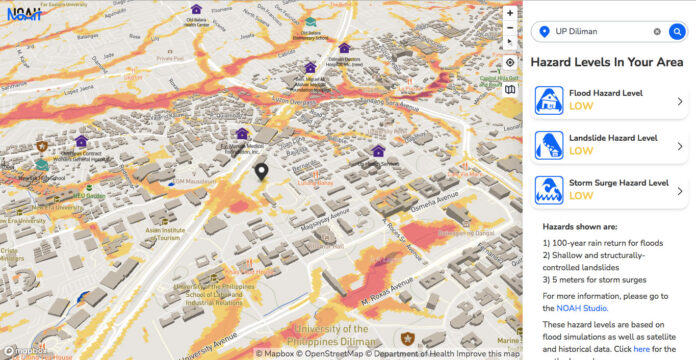The University of the Philippines Nationwide Operational Assessment of Hazards (UP NOAH) Center unveiled on Monday the new website for Project NOAH, the Philippines’ flagship disaster risk reduction and climate change adaptation project.
With an interface from Mapbox, an American provider of custom online maps, the revamped website aims to be easily understandable for both civilians who need to know potential hazards and safe locations in an area, and experts and lawmakers who need information for disaster risk-related policymaking.
“The business of hazard mapping is not just identifying the hazards, but really identifying the safe places for placing evacuation centers and citing good places to develop the community,” said Alfredo Mahar Francisco A. Lagmay, Director of the UP NOAH Center. “We’re not in the business of just mapping out the hazards per se.”
The website determines storm surge, flooding, and landslide hazards in an area, based on flood simulations and satellite and historical data, as well as critical facilities needed during disasters, like hospitals, health centers, police stations, and schools.
Improvements made include optimization for easy access via any device that has internet, a 3D terrain map that can be zoomed in and out from any elevation point, and descriptions of what to expect and how to stay safe in a disaster.
“Accurate and timely info on the NOAH website may be openly used by ordinary citizens, local government units, national government agencies, and the private sector. Doing so will help enrich their knowledge for action plans if a disaster occurs,” said Danilo L. Concepcion, UP President, at the website launch.
The UP Resilience Institute (UPRI), the state university’s program for building Filipino resilience against disaster, took on NOAH after government funding of the project halted in 2017. Since then, research and development has been geared towards bettering the website for widespread use covering all of the Philippines, with continuous collaboration in disaster planning with local governments.
With NOAH still on beta release, Dr. Lagmay called for volunteers: “Building footprints come from the UPRI youth mappers. It’s a community effort. Anyone can help with open street mapping to complete the 3D buildings on the map.” — Brontë H. Lacsamana

